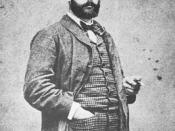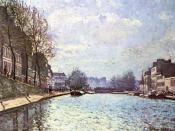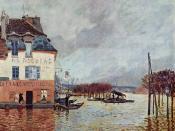'The Flood at Port-Marley' is a painting by Alfred Sisley. It was made in Louvre, Paris in the year 1876.
'The Flood at Port-Marley' places much emphasis on the sky and it is the first feature viewers notice as they look directly at the painting. It is of primary importance in the painting. There is an impression of movement of clouds in the sky, suggested by streaks of dark clouds in two horizontal lines from left to right across the canvas. This creates an illusion of the clouds passing from one side of the canvas to the other. This left to right movement coincides with the natural eye movement when reading, producing harmony within the picture. The darker clouds also display the approach of a storm and this also demonstrates further motion within the landscape.
The second most prominent feature is the building on the left-hand side. It draws the eye to this side of the painting where all the fine details are displayed.
For example, one is able to read the writing on the building and notices such intricacies as the half-drawn curtains in the windows. It is quite often unusual for such detail in an Impressionist painting. The building creates balance in the composition, by the use of two vertical forms the building and the telegraph pole.
Ripples in the water surrounding the building once again indicates a breeze blowing across the water and enhances the picture by being a contrast to the cloud formation. Alfred Sisley used a palette knife to apply oil paints in a strong and forceful manner, to define the small waves of the river. This contrasts sharply with the soft brush strokes used to merge the blue and grey colours in the sky.
Alfred Sisley was a great exponent of the use...


